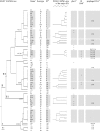Molecular characterization of human-colonizing Streptococcus agalactiae strains isolated from throat, skin, anal margin, and genital body sites
- PMID: 18632904
- PMCID: PMC2546740
- DOI: 10.1128/JCM.00421-08
Molecular characterization of human-colonizing Streptococcus agalactiae strains isolated from throat, skin, anal margin, and genital body sites
Abstract
Streptococcus agalactiae carriage was evaluated by sampling four body sites in a group of 249 healthy individuals including both sexes and a wide range of ages; the aims were to study the population structure of colonizing strains by multilocus sequence typing (MLST) and to evaluate their diversity by serotyping, SmaI macrorestriction analysis, and PCR screening for genetic markers of highly virulent clones for neonates. The prevalences of carriage were 27% in women and 32% in men. The major positive body site was the genital tract (23% in women and 21% in men); skin, throats, and anal margins were also positive in 2%, 4%, and 14%, respectively. These human-colonizing strains belonged mostly to serotypes III (24%), Ia (21%), V (18%), and Ib (17%). Twenty-three sequence types (STs) were identified. The MLST characteristics of the strains isolated from a single anatomic site-genital (vagina [women] or from a sample of the first urination after arising from a night's sleep [men]), throat, skin, or anal margin-suggest a body site colonization specificity for particular STs: strains of STs 2, 10, 19, and 196 were isolated only from genital sites; strains of STs 1, 8, and 23 were isolated more frequently from throat florae; and strains recovered only from anal margin samples were more closely related to strains isolated from throats than to those from genital sites. Most strains of STs 1, 8, and 23-STs that are increasingly described as being responsible for adult infections-did not carry any markers of strains virulent for neonates, suggesting that the virulence of these strains is probably associated with other genetic determinants. In addition, the genetic diversities of the strains varied between STs: STs 2, 8, 10, 23, and 196 were the most diverse; STs 1 and 19 were more homogeneous; and ST 17 strains formed three distant groups.
Figures

Similar articles
-
Population structure, virulence factors and resistance determinants of invasive, non-invasive and colonizing Streptococcus agalactiae in Poland.J Antimicrob Chemother. 2010 Sep;65(9):1907-14. doi: 10.1093/jac/dkq230. Epub 2010 Jun 27. J Antimicrob Chemother. 2010. PMID: 20584746
-
Genetic diversity of Streptococcus agalactiae strains and density of vaginal carriage.J Med Microbiol. 2009 Feb;58(Pt 2):169-173. doi: 10.1099/jmm.0.005827-0. J Med Microbiol. 2009. PMID: 19141732
-
Phenotypic and genotypic characterization of Streptococcus pneumoniae strains colonizing children attending day-care centers in Norway.J Clin Microbiol. 2008 Aug;46(8):2508-18. doi: 10.1128/JCM.02296-07. Epub 2008 Jun 4. J Clin Microbiol. 2008. PMID: 18524970 Free PMC article.
-
Primary carrier sites of group B streptococci in pregnant women correlated with serotype distributions and maternal parity.J Clin Pathol. 1981 Jan;34(1):78-81. doi: 10.1136/jcp.34.1.78. J Clin Pathol. 1981. PMID: 7007446 Free PMC article.
-
Sensitive Skin in the Genital Area.Front Med (Lausanne). 2019 May 15;6:96. doi: 10.3389/fmed.2019.00096. eCollection 2019. Front Med (Lausanne). 2019. PMID: 31157224 Free PMC article. Review.
Cited by
-
Identification of an unusual pattern of global gene expression in group B Streptococcus grown in human blood.PLoS One. 2009 Sep 23;4(9):e7145. doi: 10.1371/journal.pone.0007145. PLoS One. 2009. PMID: 19774088 Free PMC article.
-
Re-framing the importance of Group B Streptococcus as a gut-resident pathobiont.Infect Immun. 2024 Sep 10;92(9):e0047823. doi: 10.1128/iai.00478-23. Epub 2024 Mar 4. Infect Immun. 2024. PMID: 38436256 Free PMC article. Review.
-
The role of the local microbial ecosystem in respiratory health and disease.Philos Trans R Soc Lond B Biol Sci. 2015 Aug 19;370(1675):20140294. doi: 10.1098/rstb.2014.0294. Philos Trans R Soc Lond B Biol Sci. 2015. PMID: 26150660 Free PMC article. Review.
-
Multilocus Sequence Typing Reveals Extensive Genetic Diversity of the Emerging Fungal Pathogen Scedosporium aurantiacum.Front Cell Infect Microbiol. 2021 Dec 27;11:761596. doi: 10.3389/fcimb.2021.761596. eCollection 2021. Front Cell Infect Microbiol. 2021. PMID: 35024355 Free PMC article.
-
Association of Group B Streptococcus colonization and bovine exposure: a prospective cross-sectional cohort study.PLoS One. 2010 Jan 20;5(1):e8795. doi: 10.1371/journal.pone.0008795. PLoS One. 2010. PMID: 20098699 Free PMC article.
References
-
- Badri, M. S., S. Zawaneh, A. C. Cruz, G. Mantilla, H. Baer, W. N. Spellacy, and E. M. Ayoub. 1977. Rectal colonization with group B Streptococcus: relation to vaginal colonization of pregnant women. J. Infect. Dis. 135308-312. - PubMed
-
- Baker, C. J., D. K. Goroff, S. Alpert, V. A. Crockaett, S. H. Zinner, J. R. Evrard, B. Rosner, and W. M. McCormack. 1977. Vaginal colonization with group B Streptococcus: a study in college women. J. Infect. Dis. 135392-397. - PubMed
-
- Bidet, P., N. Brahimi, C. Chalas, Y. Aujard, and E. Bingen. 2003. Molecular characterization of serotype III group B-Streptococcus isolates causing neonatal meningitis. J. Infect. Dis. 1881132-1137. - PubMed
-
- Bliss, S. J., S. D. Manning, P. Tallman, C. J. Baker, M. D. Pearlman, C. F. Marrs, and B. Foxman. 2002. Group B Streptococcus colonization in male and nonpregnant female university students: a cross-sectional prevalence study. Clin. Infect. Dis. 34184-190. - PubMed
-
- Blumberg, H. M., D. S. Stephens, M. Modansky, M. Erwin, J. Elliot, R. R. Facklam, A. Schuchat, W. Baughman, and M. M. Farley. 1996. Invasive group B streptococcal disease: the emergence of serotype V. J. Infect. Dis. 173365-373. - PubMed
Publication types
MeSH terms
LinkOut - more resources
Full Text Sources

